Share




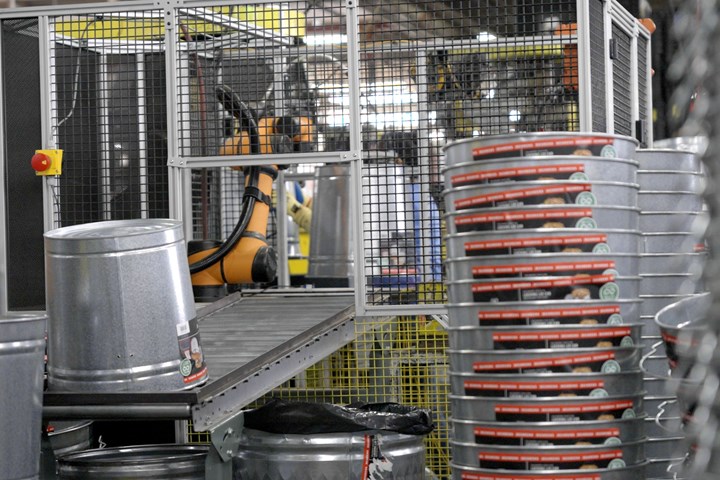
Behrens Manufacturing produces between 100 and 150 shippable SKUs of steel containers, from trash cans and pails to buckets and tubs. A typical run of parts at the Winona, Minnesota factory is 20,000 pieces or more. Photos provided by Rapid Robotics.
Behrens Manufacturing has produced galvanized steel containers, including trash cans, pails, buckets and tubs in its Winona, Minnesota factory since 1911. Manufacturing its products in America is important not only for quality purposes, but also because the company serves the agricultural industry, where supply chains need to be short to prevent disruption to the food supply.
However, keeping manufacturing in America has become more challenging between rising costs (of both material and labor) and a shortage of workers. The latter has been a particular obstacle for Behrens – in 2021, the company had more than 20 open positions it couldn’t fill. “There was just no one to hire,” says Bill Bellingham, vice president of manufacturing.
Behrens has tried many tactics to mitigate this issue. Efforts such as material flow changes and setup cost reduction resulted in small gains, and while a previous automation project with industrial robots was successful, lead times were long, and setup required significant downtime on the production line.
Plus, automation typically requires a lot of upfront investment. “We want to invest in automation to stay relevant and reduce our costs, but we have a limit on our capital expenditure,” Bellingham explains.
The company has a lot of old equipment it needs to replace (it recently removed its last machine that had been running since the inception of the company). So it turned to robotics as a service (RaaS) provider Rapid Robotics for a solution.
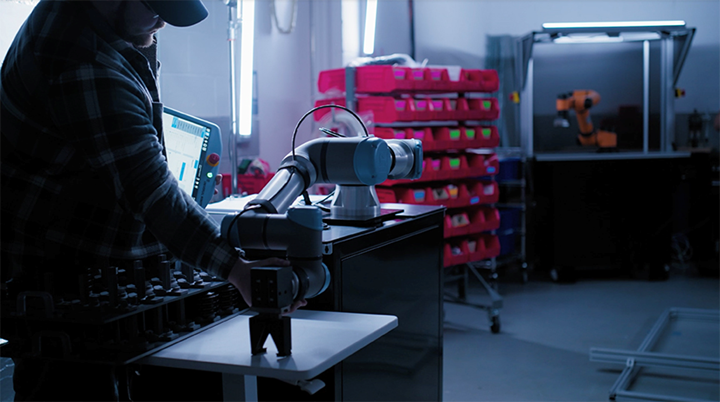
In 2021, Behrens found itself with 20 open positions and no one to hire, so it contacted Rapid Robotics to find a robotics-as-a-service (RaaS) solution. With RaaS, instead of buying automation equipment outright, users pay an upfront fee and a regular “subscription” fee to lease the system.
Payment Plans
One major difference between robotics as a service and more traditional models of automation is financing. Typically, users purchase automation equipment, such as robots or cobots, and pay integrators to set them up if necessary.
With RaaS, users don’t own the equipment. Instead, they pay an initial setup and onboarding fee, as well as a regular fee (or subscription). “You can pay it annually, quarterly, monthly, whatever is most feasible for you,” says Kim Losey, Rapid’s VP of marketing. This covers not only the cost of the hardware, but the other costs associated with design, deployment and support.
Losey acknowledges the idea of leasing or renting equipment can be a big adjustment for manufacturers who are used to buying equipment and amortizing it. And while she says that Rapid isn’t necessarily opposed to eventually selling the system to its customers, she also points out that it might not make sense. “If you're running the system for three shifts for five years, it's kind of coming to the end of its guaranteed life at that point. Do you really want to own it, or do you just want it to be our problem if it breaks, or something happens to it or it needs to be replaced?”
Instead of thinking of this as a capital expenditure, Losey suggests thinking of it as an operational expenditure. This is the view Behrens has taken. “We can pay for this robot just like we do a regular employee,” Bellingham says. Shifting the expense to the operating budget has enabled Behrens to continue investing in the new metal fabrication equipment it needs while automating.
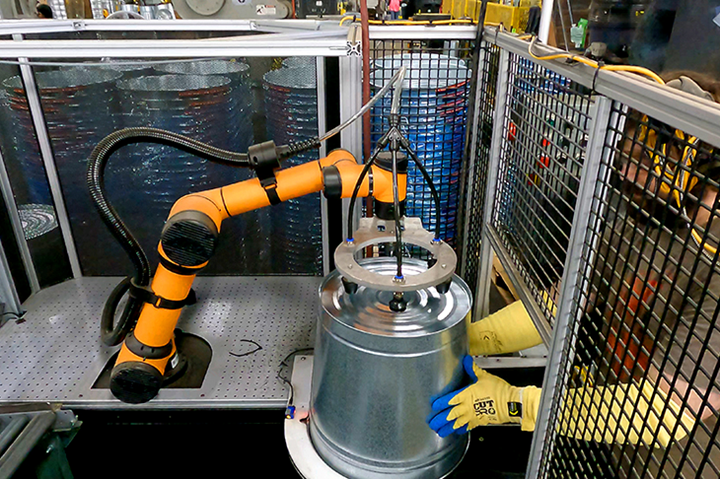
Because Rapid wants users to continue renewing their subscriptions, the company helps them choose tasks, designs the cell, implements it and provides 24/7 support. At Behrens, Rapid automated tending of a machine that pierces four holes into metal pails, where the handles are later attached.
Setting Up For Success
RaaS is more than just a way to pay. In addition to a robot or cobot from one of a number of manufacturers, Rapid’s solution (called a Rapid Machine Operator, or RMO) encompasses consultation, design, peripherals (just about anything that’s attached to the robot, from safety fencing to vision systems to custom 3D printed grippers), integration, training, service and 24/7 monitoring.
This level of involvement stems from Rapid’s interest in ensuring the solution is a success. “We are highly incentivized to make sure that our customers are happy. We want them renewing year after year,” says Steve Barsanti, VP of customer operations at Rapid. “We are not going to take on a task that we are not highly confident that we can achieve reliable automation on.”
Rapid works closely with its customers from the beginning, starting with selecting the task to automate. After an initial phone call, Rapid sends employees to do a walkthrough of the customer’s factory. “Our goal always is to have the freedom to really assess their entire floor and take more of a consultative approach,” Barsanti explains. “That gives us the freedom to say, I know that this machine over here in the corner may not be your biggest problem child, but we can take the operator that's there and put them on the project that is causing you a lot of headaches.”
Barsanti says that on the factory walk, engineers are looking for a well-established process, with parts coming in and going out repeatably, and the higher the volume, the better. For machine shops, this typically means machine tending, inspection, metal fabrication such as stamping or press tending, some postprocessing operations such as plasma treating, and packing/palletizing.
“The walk on the shop floor was eye-opening,” Bellingham says. Then Behrens and Rapid went back and forth on several proposals. “It really a good brainstorming session between both parties that ended up finding a good application,” he adds.
“The job that we ended up selecting is a job that, I guess to be frank, the employees on the line would fight over who had to do it because they hated doing it. A mundane job,” Bellingham says. “Once we proposed that to the Rapid engineers, they jumped all over it.”
The job is tending a machine that pierces four holes into a pail, where the handle is later attached. Behrens has four production lines that require this task on four different sizes of pails, so it wanted one RMO for each production line.
Once the task was chosen, Rapid moved quickly, which was important given how many people short Behrens was. Within a few days of choosing the task, Rapid had a concept for Behrens to review.
Behrens provided feedback, and after a few iterations both parties settled on a design. Within a week it was up and running at Rapid’s San Francisco office, and it arrived at Behrens a few days after that. “The implementation was, from my perspective, extremely quick, extremely painless, and took much less line downtime than what we had anticipated,” he adds. Within a few hours, the first line was starting to run parts, and it was at full production speed by the end of the day.
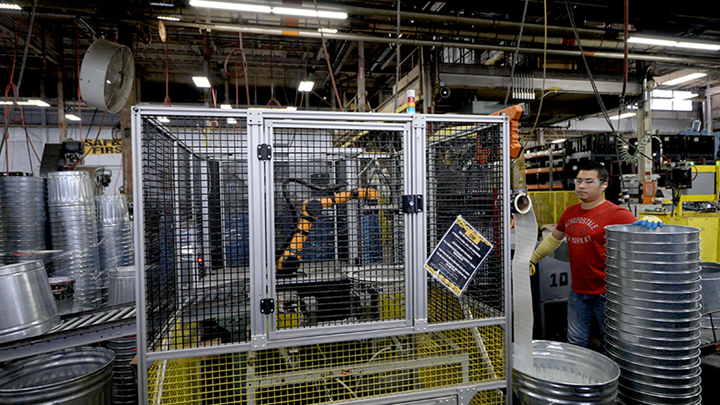
Behrens VP of Manufacturing Bill Bellingham says employees were initially apprehensive of the cobot, but the fact that it was taking over an undesirable job helped it gain acceptance. He adds that employees have grown to enjoy working with the new technology and appreciate how it helps them achieve production goals.
Support Systems
Behrens also appreciates the service aspect of Rapid’s business model, particularly the 24/7 monitoring. “When we have a problem, sometimes Rapid is calling us to say, hey, we see one of your robots is down. We're going to do this to fix it,” Bellingham says. A lot of service can be done remotely, which helps maintain uptime.
And when remote service isn’t an option, Rapid can diagnose the problem remotely, set up a replacement system in its office and bring it to the shop to swap out. Rapid takes the faulty system back to its office to fix, minimizing downtime for manufacturers.
“They did have to replace one arm for us. They had diagnosed it ahead of time. So the field service engineer and the new robot new arm arrived at the same time,” Bellingham says. “And it was swapped out within, I would say, three hours.” Under a traditional model where the manufacturer owns the robot, the user would have to wait for someone to come out to service the robot, and possibly wait for replacement parts.
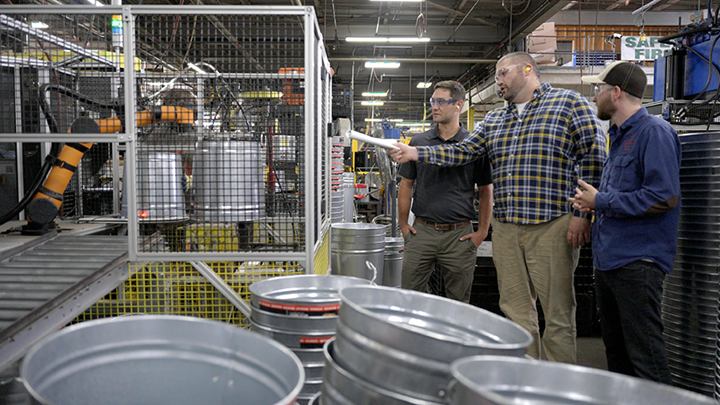
Not only has Rapid Robotics helped Behrens address its labor shortage, but Bellingham says that it’s seeing 5-10% improvements in production from the system’s consistency. The system has also enabled further downstream automation.
Automation Impacts
The RMOs have been a success at Behrens from multiple perspectives. “When we initially put the systems in, the discussion wasn't a straight ROI calculation,” Bellingham explains. The main benefit has been dealing with the labor shortage, but Behrens is also seeing a good return on investment.
At its peak production, Behrens had one employee on each of its four production lines performing this task for three shifts per day. Bellingham says that each RMO costs roughly the same as one employee, but the RMOs can work multiple shifts. So its four RMOs can take the place of as many as 12 employees. (The company has dropped from three to two shifts per day, so the RMOs now perform the work of eight employees.)
Behrens has also seen improvements to its throughput. The RMOs take 10 seconds to complete the piercing task, which is longer than the humans’ target time of seven seconds. But actual human time varied from seven to 12 seconds, slowing down as the day went on. Now, with consistent 10-second times, the robot paces the line, and Bellingham says it’s seeing 5-10% improvements just from the consistency.
In addition, the RMOs have enabled more automation downstream. The holes need to be centered around a seam on the pail, so Rapid designed a fixture that locates the seam. The next step after piercing is applying a label to the pail over the seam.
Because the fixture Rapid designed locates the seam, Behrens was able to add a label applicator to automate this task, which it wasn’t able to use before because human operators couldn’t repeatably locate the seam. The label applicator isn’t part of the Rapid solution, but the RMOs have enabled Behrens to use it.
The Rapid Machine Operators have been such a success for Behrens that Bellingham is looking for other tasks to automate. “I think the real opportunity for us is, as we upgrade our equipment, to say, okay, when we put in this modern equipment, how do we do it with a cobot so that not only can we get a reliable piece of equipment that's faster, but we can reduce the direct labor,” he says.
Related Content
Increasing Productivity with Digitalization and AI
Job shops are implementing automation and digitalization into workflows to eliminate set up time and increase repeatability in production.
Read More4 Steps to a Cobot Culture: How Thyssenkrupp Bilstein Has Answered Staffing Shortages With Economical Automation
Safe, economical automation using collaborative robots can transform a manufacturing facility and overcome staffing shortfalls, but it takes additional investment and a systemized approach to automation in order to realize this change.
Read MoreLean Approach to Automated Machine Tending Delivers Quicker Paths to Success
Almost any shop can automate at least some of its production, even in low-volume, high-mix applications. The key to getting started is finding the simplest solutions that fit your requirements. It helps to work with an automation partner that understands your needs.
Read MoreInside the Premium Machine Shop Making Fasteners
AMPG can’t help but take risks — its management doesn’t know how to run machines. But these risks have enabled it to become a runaway success in its market.
Read MoreRead Next
4 Steps to a Cobot Culture: How Thyssenkrupp Bilstein Has Answered Staffing Shortages With Economical Automation
Safe, economical automation using collaborative robots can transform a manufacturing facility and overcome staffing shortfalls, but it takes additional investment and a systemized approach to automation in order to realize this change.
Read MoreAvoiding a Failed Automation Integration
New features that simplify robot use have blurred the lines between tasks that shops can automate independently from those that will require the support of an integrator. Here’s what shops should keep in mind to avoid a costly failed integration.
Read MoreMade in the USA - Season 1 Episode 2: The Automation Puzzle
There is a fundamental question we need to answer when we talk about automation: To what extent is automation an answer to the skilled workforce shortage, and to what extent is automation vs. Skilled labor the wrong comparison to make in the first place?
Read More






























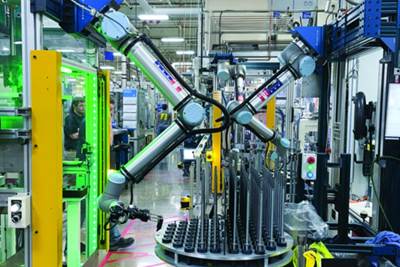
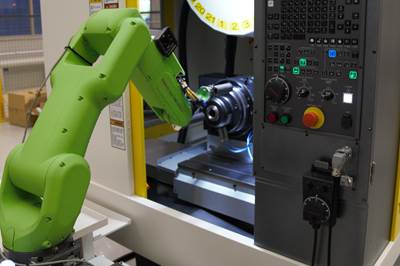
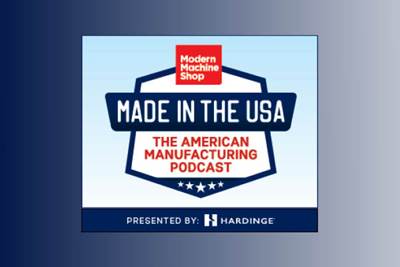
.png;maxWidth=970;quality=90)